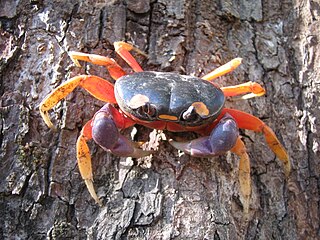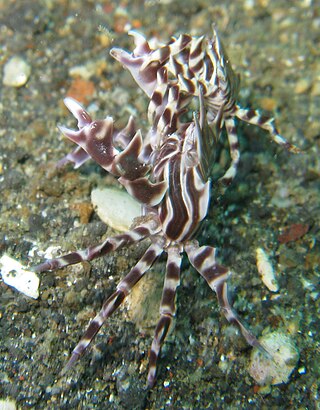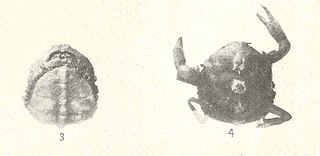
Crabs are decapod crustaceans of the infraorder Brachyura, which typically have a very short projecting tail-like abdomen, usually hidden entirely under the thorax. They live in all the world's oceans, in freshwater, and on land, are generally covered with a thick exoskeleton, and have a single pair of pincers on each arm. They first appeared during the Jurassic period, around 200 million years ago.

Scylla paramamosain is a mud crab commonly consumed in Southeast Asia.

Tuerkayana hirtipes is a species of terrestrial crab.

Astropyga radiata, the red urchin, fire urchin, false fire urchin or blue-spotted urchin, is a species of sea urchin in the family Diadematidae. It is a large species with long spines and is found in the tropical Indo-Pacific region. It was first described in 1778 by the German naturalist Nathaniel Gottfried Leske.

Gecarcinus is the type genus of the land crab family Gecarcinidae. They are found in warmer coastal regions of the Americas, including islands in the Caribbean. Four species from oceanic islands were formerly included in Gecarcinus as the subgenus Johngarthia, but are now treated as a separate genus, Johngarthia. While all members of this genus are largely terrestrial, they have to return to the ocean to breed. They are often colourful, with reddish, orange, purple, yellowish, whitish, or blackish being the dominating hues. This has resulted in some species, notably G. quadratus and G. lateralis, gaining a level of popularity in the pet trade.

Dromiacea is a group of crabs, ranked as a section. It contains 240 extant and nearly 300 extinct species. Dromiacea is the most basal grouping of Brachyura crabs, diverging the earliest in the evolutionary history, around the Late Triassic or Early Jurassic. Below is a cladogram showing Dromiacea's placement within Brachyura:

Eubrachyura is a group of decapod crustaceans comprising the more derived crabs. It is divided into two subsections, based on the position of the genital openings in the two sexes. In the Heterotremata, the openings are on the legs in the males, but on the sternum in females, while in the Thoracotremata, the openings are on the sternum in both sexes. This contrasts with the situation in other decapods, in which the genital openings are always on the legs. Heterotremata is the larger of the two groups, containing the species-rich superfamilies Xanthoidea and Pilumnoidea and all the freshwater crabs. The eubrachyura is well known for actively and constantly building its own burrows. The fossil record of the Eubrachyura extends back to the Cretaceous; the supposed Bathonian representative of the group, Hebertides jurassica, ultimately turned out to be Cenozoic in age.

Pilumnoidea is a superfamily of crabs, whose members were previously included in the Xanthoidea. The three families are unified by the free articulation of all the segments of the male crab's abdomen and by the form of the gonopods. The earliest fossils assigned to this group are of Eocene age.

Xantho poressa, the jaguar round crab, is a species of crab from the eastern Atlantic Ocean. It is one of four species in the genus Xantho.

Toxopneustes pileolus, commonly known as the flower urchin, is a widespread and commonly encountered species of sea urchin from the Indo-West Pacific. It is considered highly dangerous, as it is capable of delivering extremely painful and medically significant stings when touched. It inhabits coral reefs, seagrass beds, and rocky or sandy environments at depths of up to 90 m (295 ft). It feeds on algae, bryozoans, and organic detritus.

Gelasimus vocans is a species of fiddler crab. It is found across the Indo-Pacific from the Red Sea, Zanzibar and Madagascar to Indonesia and the central Pacific Ocean. It lives in burrows up to 50 centimetres (20 in) deep. Several forms of G. vocans have been recognised, with their authors often granting them the taxonomic rank of full species or subspecies.

Zebrida is a small genus of distinctive striped crabs, known as zebra crabs, that live in association with sea urchins in the Indo-Pacific.
Mithraculus cinctimanus is a species of crab in the family Majidae. It is found in the Caribbean region and is usually associated with a sea anemone, sponge or coral.

Paraleptuca crassipes or the thick-legged fiddler crab is a species of fiddler crab that lives in intertidal habitats distributed across the western Pacific Ocean.

Toxopneustes elegans is a species of sea urchin endemic to Japan. Like the closely related flower urchin, they are venomous.
Charybdis longicollis, the lesser swimming crab, is a species of crab from the swimming crab family, the Portunidae. It has a native range which covers the north-western Indian Ocean and it has invaded the Mediterranean Sea by Lessepsian migration through the Suez Canal.

Tubuca alcocki is a species of fiddler crab. Its range includes most of the northern Indian Ocean, from western Thailand, through the Bay of Bengal and India, to the Red Sea.

Tunicotheres is a monotypic genus of crabs in the family Pinnotheridae, and Tunicotheres moseri is the only species in the genus. This crab lives commensally in the atrial chamber of a small ascidian. It is found in the tropical western Atlantic Ocean, the Caribbean Sea and the Gulf of Mexico.

Nanhaipotamon is a genus of freshwater crabs, in the subfamily Potamiscinae, found in southern China and Taiwan. As of 2018, 18 species have been described. The genus is named after the South China Sea, for it occurs mostly in coastal areas. The genus was first described by R. Bott in 1968 as Isolapotamon (Nanhaipotamon), i.e., a subgenus of Isolapotamon.

Austruca is a genus of indo-west Pacific fiddler crabs in the family Ocypodidae. There are about 13 described species in this genus.


















